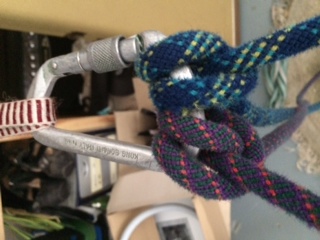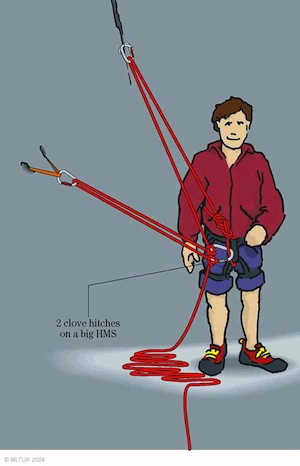Sponsored By
ROCK
HARDWARE
Chockstone Photography
Australian Landscape Prints |
 Chockstone Forum - Gear Lust / Lost & Found
Chockstone Forum - Gear Lust / Lost & Found
Rave About Your Rack Please do not post retail SPAM.
| Author |
|
|||||
4:23:19 PM |
Google qurank. Then do a site search for derating carabiners chart. I'd link it but can't seem to get it to work. | |||||
7:00:57 PM |
thanks for the link I have looked through some of my books, such as Rope techniques by Bill march, Rock climbing getting started by Glenn Tempest & Mountaineering, Freedom of the Hills I note that all show belays with coaxial loading on Crabs. Are they all in error? So after a bit of research at http://queenslandclimbing.yuku.com/reply/60839/Derating-carabiners-chart#reply-60839 re derating of binners and force factor calculation at http://www.myoan.net/climbart/climbforcecal.html and Leader falls at http://wallrat.com/PDF_Files/forcesinleadfalls.pdf I have concluded this. With my 27kn Kong binner the coaxial loading would be approx. 13kn adequate to support a shock force from a falling climber. Shock force being around 5 to 7kn rarely reaching 9kn. An interesting issue on Robs chart is the strength of two opposing gate crabs, down at 20%. I have a hard time accepting that but Iím no engineer. Coaxial loading then would seem not so serious after all ... |
|||||
10:37:55 PM |
On 1/03/2015 tooclimb wrote: > I have concluded this. With my 27kn Kong binner the coaxial loading would >be approx. 13kn adequate to support a shock force from a falling climber. >Shock force being around 5 to 7kn rarely reaching 9kn. An interesting issue >on Robs chart is the strength of two opposing gate crabs, down at 20%. >I have a hard time accepting that but Iím no engineer. >Coaxial loading then would seem not so serious after all ... I'm still not sure what you're trying to establish. While I would expect that you'll get away with it, you're operating in a an undefined zone. It's not a factory tested thing so you don't know that your Kong biner will hold 13kn if coaxially loaded. You know it will hold 27kN properly rigged so why would you rig it another way and throw away half of what you've paid for. Essentially you're throwing away your safety factor. |
|||||
9:09:05 AM |
From your response you seem to think that coaxial loading doesn't happen in your rigs. It does in mine. If you have two ropes in a binner how can it be avoided? I'm trying to establish is it safe or not as my rigs often have two ropes, or slings, or sling and rope, that potential could & do cause it. Please note that I wont be compromising anyone's safety. |
|||||
9:19:09 AM |
If I had something that I couldn't avoid triaxial loading I'd use a mallion or other piece of equipment designed for that kind of loading. Often, just using two biners instead of one will correct the issue though. Rather than:  Clip a second crab to the sling and tie each rope off to a biner. |
|||||
11:21:06 AM |
On 2/03/2015 tooclimb wrote: >From your response you seem to think that coaxial loading doesn't happen >in your rigs. I have no idea why you thought to say that. In one post I say something about how at times in climbing we all have to break the rules. >It does in mine. If you have two ropes in a binner how can it be avoided? > Strictly you can't but I would tend to use figure-8s to keep the load as close to the spine as possible rather than clove hitches in those circumstances. Using a HMS krab is also a good idea. > I'm trying to establish is it safe or not as my rigs often have two ropes, >or slings, or sling and rope, that potential could & do cause it. > >Please note that I wont be compromising anyone's safety. > If you're often building anchors with triaxial loading then you probably should be looking at your systems and finding ways to avoid it or properly deal with it. No-one is going to say it's "safe" if the manufacturers don't approve of it, which is what you seem to be after. If you're recreational climbing you can look at the unofficial test results and decide what to do. If someone's paying you to rig belays then you should follow the manufacturer's instructions. |
|||||
4:20:26 PM |
I agree with all you say kieranl. | |||||
4:24:49 PM |
I thought two opposing binners would work fine as well but not according to the derating link given earlier. | |||||
5:03:38 PM |
The de-rating of double carabiners appears to be with the load applied across both biners, ie treating it as one fat carabiner. Using two carabiners in the same master point, each with ONE clove-hitched rope aligned as near to the spine axis as possible (ie biners are opposed), would presumably be OK. |
|||||
9:44:46 PM |
 Is this the sort of thing your talking about? Doesn't seem to out of line to me. |
|||||
11:46:10 PM |
Or just use clove hitch on first biner then leave a bit of slack, then clove hitch on second biner and then run it back to yourself and single clovehitch on waist biner ... | |||||
9:44:52 AM |
Using two (or more) clove hitches on any carabiner is largely unnecessary has the potential to cause greatly decreased carabiner breaking strength. On 2/03/2015 timbigot wrote: >Is this the sort of thing your talking about? Doesn't seem to out of line >to me. That seems totally out of line to me. It is a bizarre setup that makes no sense. Why have 4 chords of rope going to the climber off only two pieces of protection? Why loop the rope at the pieces rather than clove hitching it? |
|||||
11:35:16 AM |
"That seems totally out of line to me. It is a bizarre setup that makes no sense. Why have 4 chords of rope going to the climber off only two pieces of protection? Why loop the rope at the pieces rather than clove hitching it?" This is an example, maybe unclear from the picture, of using the rope to extend the belay when the anchor points are out of reach of the stance, the loops to clove hitches make it easy to adjust the length. Using clove hitches or figure 8 knots at the pieces obviously would also work, just trickier to get it right over longer distances. Taken from http://www.ukclimbing.com/articles/page.php?id=2592. |
|||||
11:48:30 AM |
That's far from the only way of setting up an adjustable length tether though. Here's a method that only needs one strand: Clove hitch or fig-8 a single strand of rope to the bolt or protection, with enough slack that you could move wherever you wanted to if attached to the other end of this strand. Now clove hitch a carabiner to the middle of this strand, and clip it to your belay loop, such that half the strand it taught between you and the bolt or pro, and the other half is slack (and can hopefully be positioned so that you aren't going to trip over it). Adjust the single clove hitch at your belay loop to lengthen or shorten your tether. Problem solved. |
|||||
1:32:30 PM |
Who threads the rope through their harness like that? Do you enjoy the feeling of the rope rubbing against your crotch? | |||||
2:26:07 PM |
The bloke in the pic looks happy enough | |||||
4:21:57 PM |
Dude is all smiling at the camera but has forgotten to put his second on belay | |||||
6:32:34 PM |
That bloke is in the gym, belaying nobody-the rope is going down the drain. I'd guess a crab cloved up like in pic to have open gate rated strength. Why not double 'em up? If it is TR it isn't like you just ran out of gear.. | |||||
7:41:42 PM |
Sorry but I doubt that having 2 ropes tied into a HMS biner like that is going to triple the load, which is what you are saying - 24 vs 8 ... HMS loads would have to be tested at centre of basket and running two ropes through them is very common. Ie twin or double ropes, so I am guessing 2 ropes is fine . . . 2 cloves only adds another 2 ropes on either side of them, and if you oriented them so the loaded lines are both to middle then that is where most of the load would go, onto the single loaded strand near the middle, not much different really . . . Of course if it was a wide basket D style biner you may get some additional leverage load.. So really it's not that much of any issue, particularly if just being used as a personal anchor... |
|||||
8:13:38 PM |
"Dude is all smiling at the camera but has forgotten to put his second on belay" It's cos he hasn't said "safe" yet so can't remember what to do next |
| There are 52 messages in this topic. |
Home | Guide | Gallery | Tech Tips | Articles | Reviews | Dictionary | Forum | Links | About | Search
Chockstone Photography | Landscape Photography Australia | Australian Landscape Photography | Landscape Photos Australia
Please read the full disclaimer before using any information contained on these pages.
Australian Panoramic |
Australian Coast |
Australian Mountains |
Australian Countryside |
Australian Waterfalls |
Australian Lakes |
Australian Cities |
Australian Macro |
Australian Wildlife
Landscape Photo |
Landscape Photography |
Landscape Photography Australia |
Fine Art Photography |
Wilderness Photography |
Nature Photo |
Australian Landscape Photo |
Stock Photography Australia |
Landscape Photos |
Panoramic Photos |
Panoramic Photography Australia |
Australian Landscape Photography |
High Country Mountain Huts |
Mothers Day Gifts |
Gifts for Mothers Day |
Mothers Day Gift Ideas |
Ideas for Mothers Day |
Wedding Gift Ideas |
Christmas Gift Ideas |
Fathers Day Gifts |
Gifts for Fathers Day |
Fathers Day Gift Ideas |
Ideas for Fathers Day |
Landscape Prints |
Landscape Poster |
Limited Edition Prints |
Panoramic Photo |
Buy Posters |
Poster Prints
